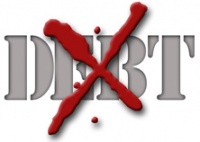 Great! You want to eliminate debt. Well, the good news is that you can.
Great! You want to eliminate debt. Well, the good news is that you can.
Now, this may seem self-evident, but the reason your debt is out of control is that you keep adding to it. Therefore,
Stop using credit.
Don’t finance anything. Cut up your credit cards. Ouch…that last one can be tough. But don’t make excuses. I don’t care that other personal finance sites say that you shouldn’t cut them up. Destroy them. Stop rationalizing that you need them. You don’t need credit cards for a safety net. You don’t need credit cards for convenience. You don’t need credit cards for cash-back bonuses.
You don’t need credit cards at all. If you’re in debt, credit cards are a trap. They only put you deeper in debt. Later, when your debts are gone and your finances are under control, maybe then you can get a credit card.
After you destroy your cards (or cut a milk carton in half, fill with water and sink your credit card in it and stick it all in the freezer – try getting your credit card out of a block of ice!), Halt any recurring payments.
If you have a gym membership, cancel it. If you automatically renew your World of Warcraft account, movie subscription, etc., cancel them. Cancel anything that automatically charges your credit card. Stop using credit.
Once you’ve halted recurring payments, call each credit card company in turn. Do not cancel your credit cards (except for those with a zero balance). Instead, ask for a better deal. Find an offer online and use it as a bargaining wedge. Your bank may not agree to match competing offers, but it probably will. It never hurts to ask.
Establish an emergency fund.
This will probably take several months to achieve. For some, this is counter-intuitive. Why save before paying off debt? Because if you don’t begin to save first, you’re not going to be able to cope with unexpected expenses. Now, don’t convince yourself to keep a credit card for emergencies. Don’t allow yourself to be dependent on a credit card. The key is to SAVE cash for emergencies.
How much should you save? Ideally, you would save $1,000 for starters. Remember, this money is for emergencies only. It is not for take-away. It is not for going out on the town. It is not for shoes. It is not for a new Playstation 3, iPad, iPhone, etc. It is to be used when your car dies, or when you break your arm in a game of touch footy.
Keep this money liquid, but not immediately accessible. Don’t tie your emergency fund to a debit card as this will only sabotage your efforts by making it too easy to spend the money on non-essentials. Consider opening an online savings account. When an emergency arises, you can easily transfer the money to your regular everyday account or go physically into the bank/Credit Union and withdraw it over the counter. Making it a bit inconvenient to access will ensure that it will be there when you need it, but you won’t be able to spend it spontaneously.
Implement a Debt Reduction Plan
This may take several years. However, after you have stopped using credit, and after you’ve saved an emergency fund, then attack your existing debt. Attack it with vigor. Throw whatever you can at it.
Using a Debt Snowball offers big payoffs. There are at least two approaches to debt elimination using the concept of a Debt Snowball.
Approach #1: Pay your high interest debts first.
- Order your debts from the highest interest rate to lowest interest rate.
- Designate a certain amount of money to pay toward debts each month.
- Pay the minimum payment on all debts except for the one with the highest interest rate .
- Throw every other cent at the debt with the highest interest rate.
- When that debt is gone, do not alter the allocated monthly amount used to pay debts, but throw all you can at the debt with the next-highest interest rate.
There’s no question that this makes the most sense mathematically. But if money were all about math, you wouldn’t have debt in the first place. Money is as much about emotion and psychology as it is about math.
Approach #2: Pay your lowest balance debts first.
Psychologically, if you can eliminate a debt really quickly and move on to the next one, it can spur you on to further debt reduction as you are encouraged by the number of diminishing debt obligations.
Here’s how you do it:
- Order your debts from lowest balance to highest balance.
- Designate a certain amount of money to pay toward debts each month.
- Pay the minimum payment on all debts except for the one with the lowest balance.
- Throw every other cent at the debt with the lowest balance.
- When that debt is gone, do not alter the monthly amount used to pay debts, but throw all you can at the debt with the next-lowest balance.
You will see results almost immediately.
Remember:
The fundamental rules are this:
- pay off debt, or save money, or accumulate wealth,
- curb spending,
- relearn frugal habits,
- and at all times, you must spend less than you earn.
The most important thing is to start now. Don’t start tomorrow. Don’t start next week. Start tackling your debt now. Your older self will thank you.
